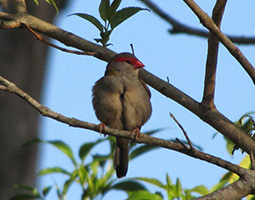Neochmia temporalis
Description

The Red-browed Finch, found on the east coast of Australia, is most easily recognised by its red eyebrow, beak and rump. The upper body is olive-green and underside grey. Male and female finches are similar in appearance, growing to 11-12 cm. Juveniles lack the red brow marks and the olive colouration on the collar and wing coverts.
The Red-browed Finch prefers grassy areas interspersed with dense understorey vegetation, often along creek lines. They congregate in small flocks between 10 and 20 individuals and require adequate shrub density to provide cover and foraging places as they are easily disturbed. They are characterised by a short, piping, high-pitched cheep or whistle.
They pair permanently, sharing nest-building, incubation and feeding of young between October and April, laying 4-5 eggs up to three times a year. The nest, woven from grass and small twigs, is large and domed with a small, side tunnel entrance built in dense, sometimes thorny, scrub, between 1 and 2 metres above the ground.
Adaptations
- Preference for open grassy areas surrounded by dense shrubbery enables the Red-browed Finch to survive well in weedy areas along railway tracks and creek lines, where seeding grasses escape the lawnmower
- When disturbed, the whole flock will disperse, cheeping, and re-congregate near-by to avoid predators
Feeding relationships
- What I eat: seeding grass heads; insects on the ground e.g. termites
- What eats me: Goshawks, Pacific Baza, Pythons
Interesting facts
The Red-browed Finch is one of only a very few small Australian birds that can be attracted to bird feeders provided that the seed is small and larger competitors are excluded.
Acknowledgements: Birdlife, Wikipedia, Australian Museum